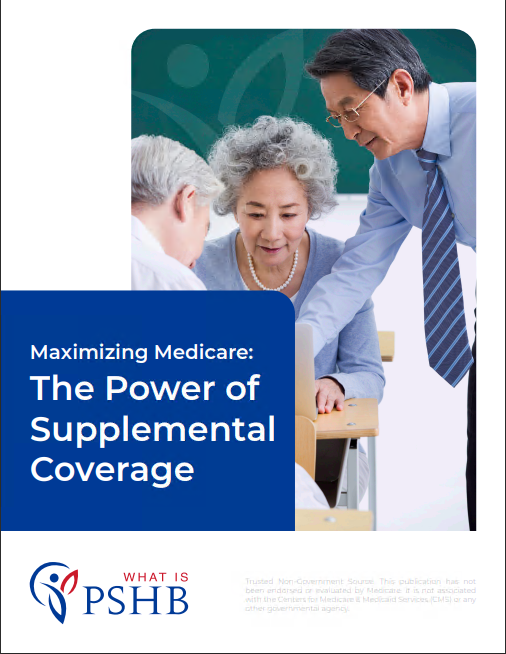Key Takeaways:
-
Medicare Part C (Medicare Advantage) and Postal Service Health Benefits (PSHB) plans provide distinct health coverage options, each with unique features, benefits, and eligibility requirements.
-
Understanding the integration between Medicare and PSHB can help you maximize your coverage and avoid unnecessary costs.
Medicare Part C: A Closer Look
Medicare Part C, also known as Medicare Advantage, offers an alternative to Original Medicare. These plans are provided by private insurers approved by Medicare and bundle the benefits of Part A (hospital insurance) and Part B (medical insurance). Some plans may include additional coverage, such as prescription drugs, vision, dental, and hearing services.
What Medicare Part C Offers
-
Comprehensive Coverage: Medicare Advantage plans consolidate multiple benefits into one package, potentially simplifying your healthcare management.
-
Annual Out-of-Pocket Limits: Unlike Original Medicare, Part C plans cap your annual expenses, offering financial protection for significant healthcare costs.
-
Preventive and Wellness Services: Many plans emphasize preventive care, including routine checkups, screenings, and wellness programs to support your overall health.
Medicare Advantage plans may also include extra benefits that Original Medicare does not cover. These can range from fitness programs to transportation services for medical appointments, enhancing both convenience and wellness.
Who Is Eligible?
To enroll in Medicare Part C, you must:
-
Be enrolled in both Medicare Parts A and B.
-
Live in the plan’s service area.
-
Not have end-stage renal disease (ESRD), with some exceptions.
Certain plans may have additional eligibility requirements, so it’s essential to confirm these details with your provider.
Enrollment Timelines
Key enrollment periods for Medicare Part C include:
-
Initial Enrollment Period (IEP): A 7-month window surrounding your 65th birthday.
-
Annual Enrollment Period (AEP): October 15 to December 7 each year, when you can join, switch, or drop plans.
-
Medicare Advantage Open Enrollment Period (MA OEP): January 1 to March 31, allowing current enrollees to switch plans or return to Original Medicare.
Understanding these timelines ensures you don’t miss an opportunity to adjust your healthcare coverage as needed.
The Postal Service Health Benefits Program
The PSHB program, exclusive to Postal Service employees, retirees, and their eligible family members, replaces the Federal Employees Health Benefits (FEHB) program for USPS enrollees starting in 2025. This transition introduces new plan options designed specifically for postal workers, enhancing access to tailored benefits and integrating Medicare for eligible participants.
Key Features of PSHB Plans
-
Comprehensive Coverage: PSHB plans include a range of services, such as inpatient and outpatient care, preventive services, and prescription drugs.
-
Customizable Options: Enrollees can choose from various plans to match their healthcare needs and budget.
-
Medicare Integration: For retirees and family members eligible for Medicare, PSHB plans work alongside Medicare Parts A and B to reduce costs and expand coverage.
PSHB plans also emphasize convenience by integrating digital tools for managing benefits and accessing telehealth services, making healthcare more accessible.
Eligibility Criteria
To qualify for PSHB, you must:
-
Be an active USPS employee or retiree.
-
Enroll during designated periods or qualify for a Special Enrollment Period (SEP) due to specific life events, such as marriage or loss of other coverage.
Enrollment Periods
The 2025 Open Season ended on December 13, 2024. For 2025, changes to your plan can only be made during the next Open Season or in response to a qualifying life event (QLE).
Being aware of these enrollment periods ensures you can make timely adjustments to your healthcare coverage.
Comparing Medicare Part C and PSHB Plans
Both Medicare Part C and PSHB plans offer valuable healthcare coverage, but their differences can influence your decision.
Cost Considerations
-
Medicare Part C: Costs include premiums, deductibles, copayments, and coinsurance, which vary by plan and location. Medicare Advantage plans also have a cap on annual out-of-pocket expenses.
-
PSHB Plans: Premiums, deductibles, and coinsurance rates depend on the chosen plan tier. The government contributes approximately 70% of premium costs for active employees and retirees.
When assessing costs, it’s crucial to consider additional benefits that may offset out-of-pocket expenses, such as fitness memberships or wellness programs.
Coverage Options
-
Medicare Part C: Offers a bundled approach to healthcare with additional benefits like prescription drug coverage.
-
PSHB Plans: Designed to complement Medicare for retirees, offering reduced deductibles and lower copayments for those enrolled in Medicare Part B.
Network Restrictions
-
Medicare Part C: Coverage is often limited to a specific network of providers, depending on the plan.
-
PSHB Plans: May offer broader access to providers, particularly for in-network services.
Navigating Medicare and PSHB Integration
For Medicare-eligible USPS retirees and family members, understanding how Medicare and PSHB plans work together is essential. Coordination between these programs can significantly enhance your healthcare benefits while minimizing costs.
Medicare Part B Enrollment Requirement
As of 2025, most Medicare-eligible Postal Service retirees must enroll in Medicare Part B to maintain PSHB coverage. Exceptions apply to those who retired before January 1, 2025, or employees aged 64 or older on January 1, 2025.
This requirement helps ensure seamless coordination between Medicare and PSHB, optimizing your benefits.
Prescription Drug Coverage
PSHB plans include prescription drug benefits through a Medicare Part D Employer Group Waiver Plan (EGWP), reducing out-of-pocket costs for medications.
By using the EGWP structure, these plans provide a streamlined and cost-effective approach to managing prescription drug expenses.
Maximizing Your Coverage
-
Use In-Network Providers: Both Medicare Advantage and PSHB plans offer the best benefits when you stick to their respective networks.
-
Coordinate Benefits: Ensure that Medicare pays first, followed by PSHB, to minimize out-of-pocket expenses.
-
Review Annual Notices: Stay informed about plan changes, including premiums, deductibles, and coverage options.
Taking a proactive approach to understanding your coverage can lead to significant cost savings and improved healthcare outcomes.
Making the Best Choice for Your Needs
When deciding between Medicare Part C and PSHB plans, consider these factors:
Your Healthcare Needs
Evaluate your medical history and anticipated healthcare requirements. If you require specialized services or frequent medical care, a plan with comprehensive coverage and low out-of-pocket limits may be ideal.
Financial Considerations
Compare the costs associated with premiums, deductibles, and coinsurance. Remember to factor in additional expenses like prescription drugs and supplemental benefits.
By carefully weighing these financial factors, you can choose a plan that aligns with your budget while meeting your healthcare needs.
Flexibility
Consider the flexibility of each plan’s network and the ease of accessing care while traveling or relocating. Medicare Part C plans may have more restrictive networks than PSHB options.
Flexibility in provider access and geographic coverage can be a deciding factor, particularly for retirees who travel frequently.
What’s Next for Postal Service Employees and Retirees?
As you navigate your healthcare options in 2025, staying proactive is crucial. Whether you’re selecting a Medicare Advantage plan, enrolling in a PSHB plan, or coordinating benefits between the two, understanding your choices will ensure you make informed decisions for your health and financial well-being.
Steps to Take Now
-
Review Your Current Coverage: Understand the strengths and limitations of your existing plan.
-
Evaluate Medicare Integration: If eligible, assess how Medicare Parts A and B complement your PSHB benefits.
-
Seek Guidance: Consult with a benefits specialist or attend informational sessions to clarify your options.
Staying informed empowers you to make decisions that prioritize your well-being and financial security.
Your Health Coverage Matters
Choosing between Medicare Part C and PSHB plans is a significant decision, especially for Postal Service employees and retirees navigating the 2025 healthcare landscape. By staying informed and actively reviewing your options, you can find the coverage that best suits your needs and provides peace of mind for the future.






